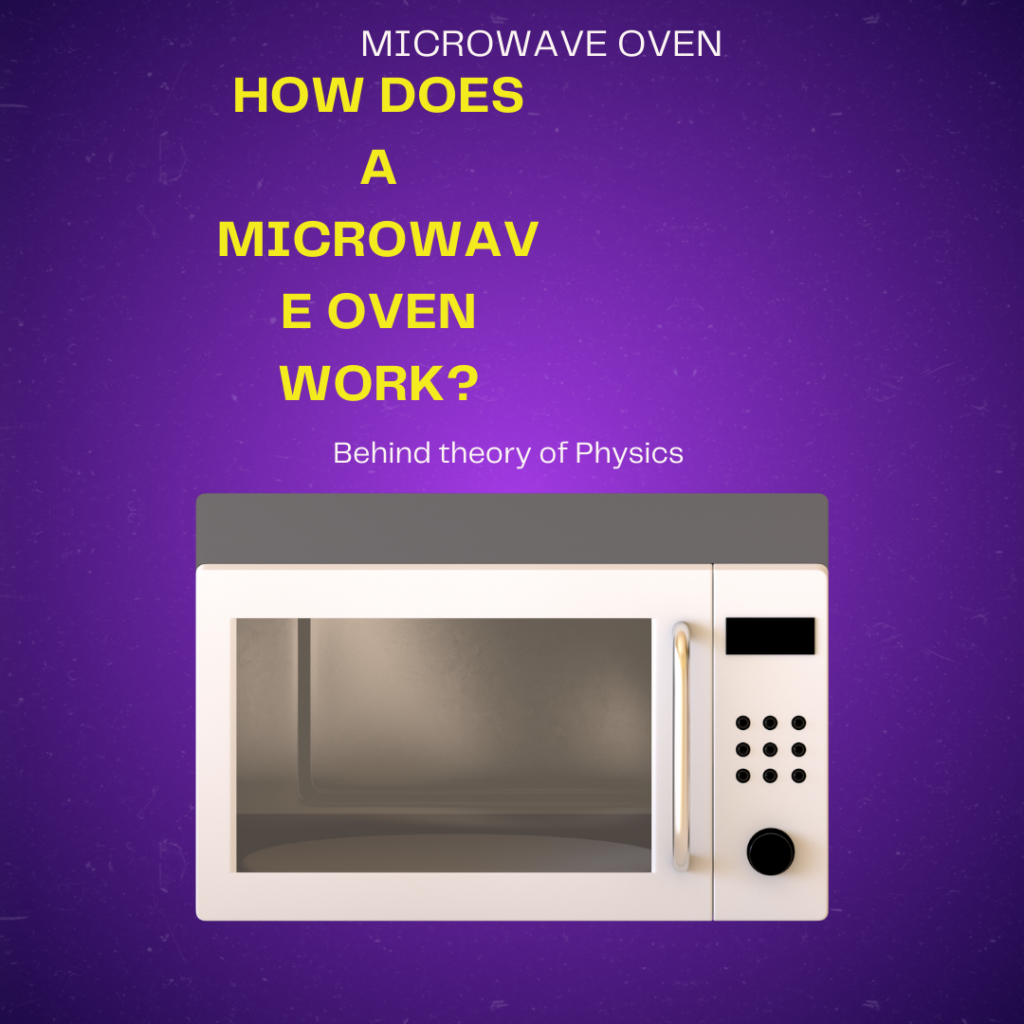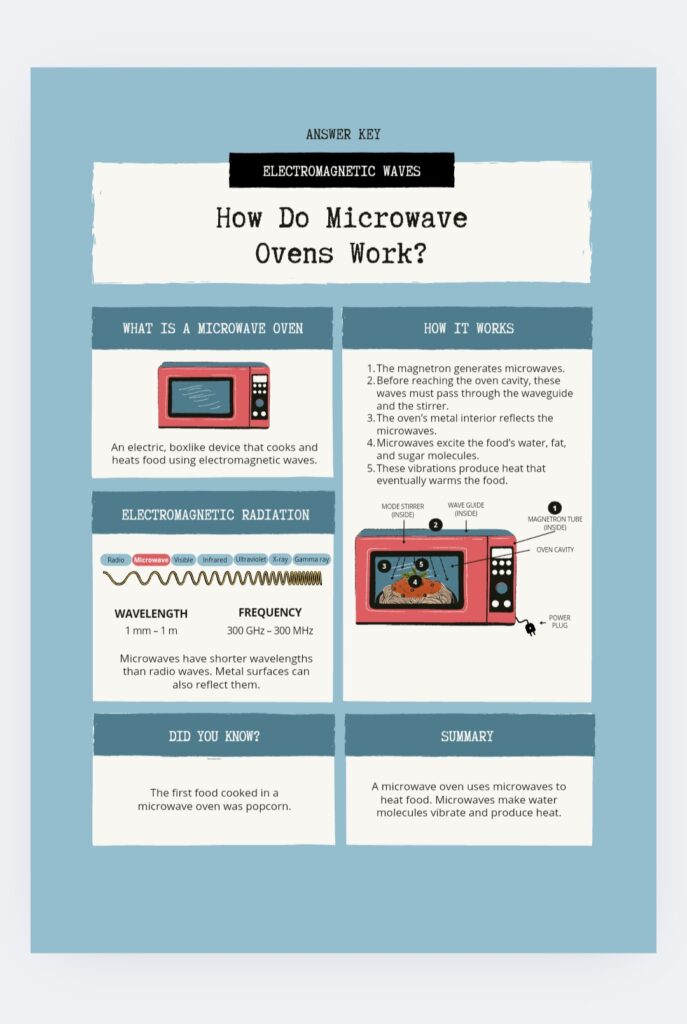How does a microwave oven work?

How Does a Microwave Oven Work? The Simple Science
How does a Microwave oven work? Have you ever thought about how a microwave oven can heat food or drink in a very short time with no flames or stovetops? You literally push a button, and in seconds it is ready; your coffee mug is steaming, or your pizza slice is hot. But how does it work? Well, the answer lies in the invisible world of physics.
In this article, we will try to make the science of a microwave oven as simple as possible, with the simplest words and examples from your everyday life. We will discuss how it works and what physics goes into making a microwave oven.
What is a Microwave Oven?
How does a Microwave oven work?
A microwave oven is an appliance that heats or cooks food using microwave radiation, a form of electromagnetic radiation. A microwave oven is also different from an oven since it does not heat food with heat, such as hot air or flame. A microwave oven uses energy waves that cause the water molecules in food to move (or vibrate), and the motion of the water molecules creates heat.
What Are Microwaves?
Microwaves are a form of electromagnetic radiation just like visible light, radio waves, x-rays, and infrared. Although we cannot see microwaves, they still carry energy.
The microwave ovens we use in our kitchens operate with a frequency of approximately 2.45 GHz (gigahertz).
This frequency is ideal for agitating our food for certain types of cooking because it easily agitates the water, fat, and sugar molecules that are common to most food.
It’s handy to think about microwaves as little energy waves that agitate the water molecules. The more agitation of the molecules, the higher the temperature of the food.
The Main Part of the Microwave: The Magnetron
The principal part of the microwave oven is a component referred to as the magnetron.

So, what does the magnetron do?
It takes electrical energy from your wall socket and converts it to microwave radiation.
It sends those microwaves into the cooking space (the metal box where you place your food).
The microwaves bounce off the metal walls and into the food.
How Does a Microwave Heat Food
How does a Microwave oven work?
This is where the physics gets really fun-but we will keep it easy.
Food has water molecules in it, and those molecules have two sides, a positive side and a negative side so they are kind of like tiny magnets. The microwaves cause an electric field that changes direction very very rapidly-2.45 billion times per second!
The quickly swapping effect causes water molecules to
– Spin and twist
– Rub together
– Create friction, creating heat.
This is why the food heats from the inside out (not merely from the outside, as in traditional cooking).
Why Doesn’t the Plate Heat up Immediately?
There are times when your food is hot but the plate is not. Why is physical chemistry different here?
How does a Microwave oven work?
Because:
Most of the microwave energy is absorbed by items that have a lot of water.
Ceramic, glass, or plastic plates do not have water inside, so they do not absorb a lot of microwave energy.
They are primarily heated because they were in contact with hot food.
Is the Microwave Oven Safe?
How does a Microwave oven work?
Yes, microwave ovens are very safe if you use them properly.
The metal casing of the oven keeps the microwaves inside the oven when the oven is being used.
The window door on the microwave oven has a metal mesh that allows you to see inside, but prevents some microwaves from leaving the oven.
As soon as you open the door, the magnetron which produces the microwaves is able to receive a signal that tells it to stop producing microwaves.T
here is also another piece of information which is relevant to safety in regard to microwaves. When heat is applied to food, microwaves do not get “stuck” inside a food or drink. As soon as there is no more cooking time or the time expires, the microwave stops and the food does not remain radioactive – that is a myth.
Physics Principles Behind Microwaves
How does a Microwave oven work?
Now let’s take a look at the physics principles in microwaves as simply as possible:
1. Electromagnetic Waves
Microwaves are electromagnetic waves of energy that travel through space.
They interact with only certain materials (here we would be looking at their interaction with water molecules).

2. Electric Fields
Microwaves contain changing electric fields.
These electric fields cause the molecules to move, which is heat.
3. Generally Friction and Heat
Moving molecules tend to rub against one another (much like rubbing hands together, where, yes, heat is generated).
This rubbing together of the molecules is generating thermal energy, which is what heats your food.
4. Resonance
Molecules of water, like other molecules, naturally resonate at microwave frequency (2.45 GHz). This is like swinging a swing if you push it with little pushes always at the right time; the little pushes eventually lead to big pushes.
Why Doesn’t Metal Work in a Microwave?
How does a Microwave oven work?
Putting metal in a microwave can spark and cause fires. That is due to:
– Metal reflects microwaves.
– When the reflecting surface is “sharp” or thin (like foil), it produces electric arcs (sparks).
So unless it is a metal “mesh” that is microwave-safe (like the above example about the “door”), don’t put metal inside.

Why Does Food Sometimes Heat Unevenly?
If you have ever observed that your food can get very hot in one area and remain cold in another area, this can happen because:
– Microwaves may not equally reach all areas distributed throughout the food.
– When food is too thick, microwaves can’t penetrate very deeply.
That is also why most microwaves have a rotating plate, to mask this issue by rotating the microwaves across the plate uniformly.
Here is a short analogy: Dancing Molecules
Think of microwaves as music and water molecules as dancers:
When you start to play the music (microwaves), then the dancers (molecules) will start to move.
So if faster music = faster dancing = more energy = heat.
That is basically what is happening inside your microwave!
Conclusion: Science in Your Kitchen
How does a Microwave oven work?
A microwave oven is no longer just a device that cooks food so you don’t have to waste your time. It is using an application of physics, and it is a great application of physics! A microwave turns electricity into microwaves, and then uses the microwaves to shake water molecules to heat food quickly, efficiently, and safely.
Here is a quick review of what we covered.
Microwaves are energy waves that cause water molecules to shake.
The microwave uses a magnetron to generate these microwaves (the magnetron can be rated from 600 Watts to 1200 Watts for household use).
Molecules shake when exposed to microwaves, and the shaking produces heat and cooks your food.
This is basically the idea of how physics concepts of electromagnetic waves, electric field, and molecular motion fit together.
So, the next time you heat old spaghetti in the microwave, remember you are using “invisible” waves and physics to make your life easier!
Frequently Asked Questions:
Q1. What are microwaves and what is the process that a microwave oven uses to heat food?
Answer:
Microwaves are electromagnetic waves just like radio waves and light waves, but with a given frequency (about 2.45 GHz) that causes water molecules to vibrate. The friction created by the vibrating molecules creates heat that begins the cooking process.
Physics concept:
Electromagnetic radiation
Molecular vibration and kinetic energy
—
Q2. What is the purpose of the magnetron in a microwave oven?
Answer:
The magnetron is a special vacuum tube contained in the oven that converts electricity to microwave energy. The magnetron produces or generates the microwaves that heat the food.
Physics concept:
Electromagnetic wave generation
Energy conversion: electrical to electromagnetic
—
Q3. Why does food get heated from the inside out in a microwave oven?
Answer:
Microwaves penetrate food and excite water molecules throughout the food, not just on the surface. This causes heat to be created from the inside of the food, although the outer layers will still heat faster than the inside due to contact with the hot container.
Physics concept:
Penetration of waves into materials
Dielectric heating
Q4. Why does metal spark in a microwave?
Answer:
Microwaves cause electric currents to flow along the surfaces of metals. Sharp edges or crumpled foil can cause the electric current to concentrate so that it begins to arc (create sparks). This is why the presence of metals in a microwave can be dangerous.
Physics concept:
Electromagnetic wave reflection
Electric waves-as energy conversion
Q5. Why do some parts of food stay cold?
Answer:
The microwaves may not reach all areas equally due to wave interference or uneven distribution when cooking. And when some types of food are thick or dense in a little box, they can block some of the wave penetration.
Physics Concept:
Standing waves
Interference and absorption
Q6. What materials can be in the microwave safely?
Answer:
Materials such as glass, ceramic, and many plastics are safe because they do not absorb microwaves. Metal materials reflect microwaves, whereas some plastics may melt.
Physics Concept:
Microwave transparency and absorption
Material attributes and wave interaction
Q7. How can microwaves heat things without fire?
Answer:
Microwaves create motion in the water molecules. Their velocity and consequently the kinetic energy raise the temperature of the water molecules (thermal energy) without using fire to induce the reaction.
Physics Concept:
Kinetic energy and thermal energy
No fire combustion is required
Q8. Can microwaves leak out of the oven?
Answer:
No. The microwaves are trapped in the metal box. As part of the microwave oven design, the metal screen mesh on the door helps keep the radiation inside the box.
Physics Concept:
Faraday cage
Wave shielding
Q9. Do microwaves stay in the food?
Answer:
No. There are no microwaves left in the food once the oven is turned off. There are no microwaves left in the food. The food does not become radioactive because it contains microwaves.
Physics Concept:
No residual radiation
Energy transfer not radiation emission

Pingback: How does a ATM Machine work? - Topbloggs
Pingback: History of Maratha Empire - nearlibrary.com